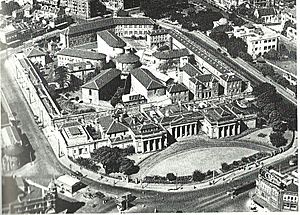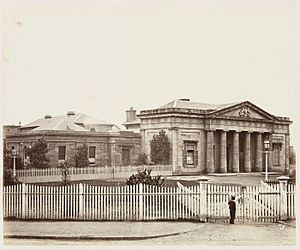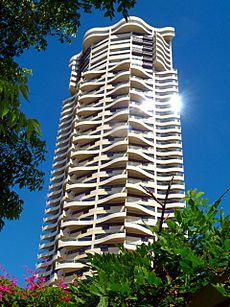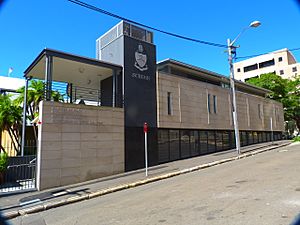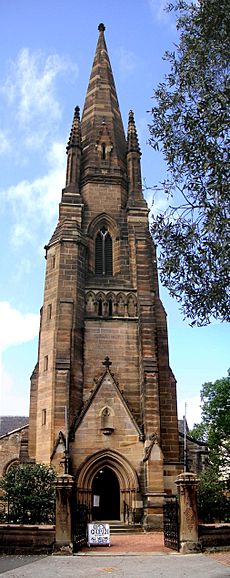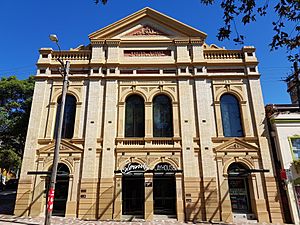Darlinghurst facts for kids
Quick facts for kids DarlinghurstSydney, New South Wales |
|||||||||||||||
|---|---|---|---|---|---|---|---|---|---|---|---|---|---|---|---|
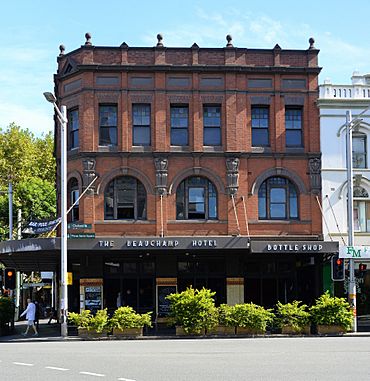
Beauchamp Hotel, Darlinghurst
|
|||||||||||||||
| • Density | 11,470.0/km2 (29,707/sq mi) | ||||||||||||||
| Postcode(s) | 2010 | ||||||||||||||
| Elevation | 52 m (171 ft) | ||||||||||||||
| Area | 0.8 km2 (0.3 sq mi) | ||||||||||||||
| Location | 1 km (1 mi) east of Sydney CBD | ||||||||||||||
| LGA(s) | City of Sydney | ||||||||||||||
| State electorate(s) | Sydney | ||||||||||||||
| Federal Division(s) | Sydney | ||||||||||||||
|
|||||||||||||||
Darlinghurst is a lively suburb right next to the Sydney central business district (CBD) in New South Wales, Australia. It's just east of Hyde Park and is part of the City of Sydney. People often call it "Darlo" for short.
Darlinghurst is a busy place where many people live in apartments or terraced houses. It used to be a less developed area, but since the 1980s, it has become a modern and exciting place. Streets like Victoria Street, Stanley Street (known as Little Italy), and Crown Street (famous for vintage fashion) are popular spots. These areas have lots of shops, cafes, and bars, all connected by small laneways.
Many young people live in Darlinghurst, and most of the businesses are small, local shops. Over half of the businesses focus on things people buy every day, like cool clothes, food, drinks, and personal services. Darlinghurst is also home to many creative businesses, like art studios.
The main street in Darlinghurst is Oxford Street. This important road runs from Hyde Park through Darlinghurst and Paddington all the way to Bondi Junction. Oxford Street is famous for its shopping and dining. The part of Oxford Street in Darlinghurst is known worldwide as a very welcoming place for everyone, especially the LGBTQ+ community. It's also the route for the yearly Sydney Mardi Gras parade, a big celebration of diversity. After some changes in local laws, the area now has many small bars, restaurants, and cafes.
Darlinghurst has several smaller areas within it, like Taylor Square and Three Saints Square. There's also an area sometimes called East Sydney, especially around Stanley Street. This name comes from a long time ago when a larger area to the east of Sydney's CBD was known as the Division of East Sydney.
Darlinghurst shares a postcode (2010) with its neighbour Surry Hills. Together with Paddington, Woolloomooloo, Rushcutters Bay, and Potts Point, they form the East Sydney region. Even though it's very close to the Sydney CBD, this area feels different. It's separated by landmarks like Central railway station, Hyde Park, St Mary's Cathedral, and The Domain. East Sydney is also known for its many great restaurants.
Contents
Discovering Darlinghurst's Past
The land where Darlinghurst now stands originally belonged to the Gadigal people. They continued to visit and use this area even into the 1840s.
Early European settlers didn't develop this area much at first because of its rocky land. However, they did quarry sandstone here, using the help of convict labour. This continued for many years, with prisoners from the nearby Darlinghurst Gaol also helping.
In the 1800s, Darlinghurst's high ridge was perfect for windmills that used the harbour breezes. Several windmills were built here, including one by Thomas Clarkson around 1819. The last of these windmills, the Craigend mill, stood until about 1873.
The area was first called Eastern Hill, then Henrietta Town, named after Governor Lachlan Macquarie's wife, Henrietta. Later, it was renamed Darlinghurst to honour Eliza Darling, the popular wife of Governor Ralph Darling. The word 'hurst' means a wooded area in Old English.
Darlinghurst became a very fashionable place after Governor Ralph Darling chose the ridge for homes of important people. Between 1828 and 1831, he gave land to wealthy merchants and officials. He made strict rules: houses had to be worth a lot of money (over £1000), and each piece of land could only have one house with a beautiful garden. Four of these grand houses were in Darlinghurst, and one, called Barham, still stands today within the grounds of SCEGGS Darlinghurst school.
The area became less fashionable after the Darlinghurst Gaol (prison) opened in 1841. Later, some factories were built here, like Sargent's Pies, which made 150,000 pies a week by 1913!
The famous Australian author Ethel Pedley, who wrote Dot and the Kangaroo, lived in Darlinghurst and sadly passed away here in 1898.
In 1973, local residents and workers joined together in a "green ban" to stop big commercial buildings from being built. They wanted to make sure there was enough affordable housing for families in the area.
Famous Places in Darlinghurst
Darlinghurst is home to some important places. You can visit two of Sydney's museums here: the Australian Museum, which is a natural history museum, and the Sydney Jewish Museum. The suburb also has St Vincent's Hospital, a major hospital.
Darlinghurst Gaol
The Darlinghurst Gaol is a large sandstone building in the middle of Darlinghurst. It was built between 1836 and 1840. The old sandstone walls still have markings made by convicts. The famous Australian poet Henry Lawson was held here for a time. Since 1995, this historic site has been home to the National Art School, where students learn about art.
Darlinghurst Fire Station
Darlinghurst Fire Station was finished in 1912. This three-storey building, made of brick and stone, stands out at the corner of Darlinghurst Road and Victoria Street. It was designed by Walter Liberty Vernon and still works as a fire station today. It's considered a special heritage building.
Darlinghurst Courthouse
The Darlinghurst Courthouse is an impressive sandstone building at Taylor Square. It was designed in 1844 by architect Mortimer Lewis and looks like a Greek temple.
Oxford Street
Oxford Street is the main shopping and business street in Darlinghurst. It starts near Hyde Park and goes through Taylor Square and beyond into other suburbs. It was originally called The South Head Road and was built starting in 1811. It used to be a toll road, meaning you had to pay to use it! Oxford Street got its current name in 1875.
Stanley Street
Stanley Street is one of Darlinghurst's popular streets for restaurants. It's often called Sydney's first "Little Italy" because of its Italian restaurants, but you can also find Japanese and Thai food here. Every June, there's an annual Italian Festival on this street.
Victoria Street
Victoria Street is another great street for cafes and restaurants. Many cafes have outdoor seating, perfect for enjoying the weather. Some well-known places like Tropicana and Bar Coluzzi are located here.
The Horizon Apartments
The Horizon is a very tall residential building in Forbes Street, Darlinghurst. It has 43 floors and was finished in 1998. It has a unique wavy shape. Some people didn't like it at first because it was one of the first tall buildings in an area that mostly had shorter ones, and they worried it would block the sun. The Horizon has apartments, car parks, a swimming pool, a tennis court, and gardens.
People and Life in Darlinghurst
At the 2021 census, Darlinghurst had 10,615 people living there. Many young people live in Darlinghurst. About 52.7% of people were born in Australia, and others came from countries like England, New Zealand, Thailand, and the United States. Most people (71.8%) speak only English at home, but other languages like Spanish, Thai, and Mandarin are also spoken. Many people in Darlinghurst say they don't have a religion (54.3%). Most homes are apartments (78.8%) or terrace houses (19.6%).
Shopping and Fun
Darlinghurst's main shopping and entertainment area is along Oxford Street. You'll also find lots of shops, cafes, and restaurants on Victoria Street, Flinders Street, Crown Street, William Street, and Darlinghurst Road. There are many places to eat and drink, as well as fashion stores.
Getting Around
Darlinghurst is easy to get to by public transport. Many bus routes from the Eastern Suburbs go through Oxford Street on their way to the Sydney central business district. Bus route 333, which goes between Circular Quay and Bondi Beach, travels through Darlinghurst. Other bus routes like 352, 373, 396, and 440 also pass through.
While there are no train stations right inside Darlinghurst, Kings Cross railway station is just north of the suburb. Museum station is also very close, just west of Darlinghurst, near Hyde Park.
Schools in Darlinghurst
Darlinghurst has several schools for different ages:
- Darlinghurst Public School opened in 1884 and teaches boys and girls from Kindergarten to Year 6.
- Sydney Grammar School is a private school for boys that opened in 1857. It's located near Hyde Park.
- Sydney Church of England Girls' Grammar School (now called SCEGGS Darlinghurst) was founded in 1895. It moved to its current location in Forbes Street in 1901.
- The National Art School is a special art school that has been around since 1859.
- The University of Notre Dame has its School of Medicine and School of Nursing here, using historic church buildings.
Churches in Darlinghurst
Darlinghurst has four active churches:
- God in the City (an Assemblies of God church)
- St. Pauls Lutheran Church
- St John's, an Anglican church that also runs a community centre called Rough Edges, which helps people in need, including those experiencing homelessness.
- Sacred Heart Catholic Church, located at the corner of Darlinghurst Road and Oxford Street.
There are also other religious groups and chapels connected to St Vincent's Hospital.
Heritage Buildings
Darlinghurst has many buildings that are protected because of their history and special design. These are listed on the New South Wales State Heritage Register. Some examples include:
- St Peter's Church on Bourke Street
- The Bourke Street Wesleyan Chapel
- The St Sophia Greek Orthodox Church
- Historic homes like Stoneleigh and Iona on Darley Street
- St John's Anglican Church on Darlinghurst Road
- The GA Zink and Sons Building on Oxford Street
- The Darlinghurst Courthouse at Taylor Square
- The Taylor Square Substation No. 6 and Underground Conveniences
- William House on William Street
Culture and Arts
Darlinghurst is famous for the annual Sydney Gay and Lesbian Mardi Gras. This big parade, which started as a protest march in 1978, happens on Oxford Street and marks the end of a three-week festival.
The Sydney Jewish Museum is on Darlinghurst Road and Burton Street. It has exhibitions that teach visitors about the Jewish community in Sydney.
Darlinghurst has many small private art galleries where you can see amazing artworks, often by Australian artists. These include Black Eye Gallery (photography), King Street Gallery on William (paintings), Conny Dietzschold Gallery (contemporary art), Stanley Street Gallery (contemporary art), Robin Gibson (paintings, sculptures), Gallery 9 (contemporary art), and Liverpool Street Gallery (contemporary art). Entry to these galleries is usually free. The National Art School also has a gallery with exhibitions.
The Eternity Playhouse on Burton Street opened in 2013. It used to be an old church, but it was beautifully renovated into a 200-seat theatre. It's now the home of the Darlinghurst Theatre Company.
Notable People from Darlinghurst
Many interesting people have lived in Darlinghurst over the years, including:
- Phillip Adams (1939–), a famous Australian writer and broadcaster.
- Ethel Pedley (1859–1898), the author of Dot and the Kangaroo.
- Michael Hutchence (1960–1997), the lead singer of the band INXS.
- Baz Luhrmann (1962–) and Catherine Martin (1965–), the famous film director and costume designer, who lived in the historic Iona house.
- Karl Stefanovic (1974–), a well-known TV host.
Images for kids
-
Stoneleigh, Darley Street



